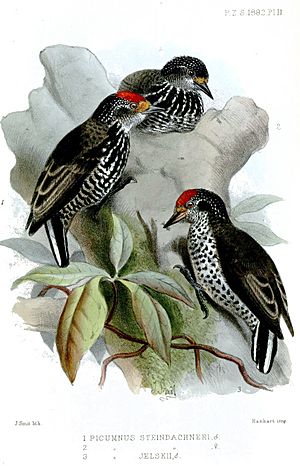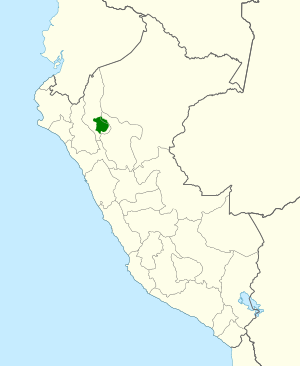Speckle-chested piculet facts for kids
Quick facts for kids Speckle-chested piculet |
|
|---|---|
 |
|
| Male and female speckle-chested piculet (above), male ocellated piculet (below) | |
| Conservation status | |
| Scientific classification | |
| Genus: |
Picumnus
|
| Species: |
steindachneri
|
 |
|
The speckle-chested piculet (Picumnus steindachneri) is a tiny bird that belongs to the woodpecker family. It is a special kind of woodpecker found only in Peru. This bird is currently considered an endangered species, which means its population is very small and it needs protection.
Contents
What Does It Look Like?
The speckle-chested piculet is a small bird, about 9 to 10 centimeters (3.5 to 4 inches) long. It weighs around 10 grams (less than half an ounce), which is about the same as two nickels!
Male and female piculets look very similar.
- They have a black cap on their head.
- Males have a red patch on their forehead, while females have small white spots there.
- Their backs are grayish-brown with feathers that have pale edges, making them look a bit scaly.
- Their tail is dark, but the outer feathers have white patches.
- The most unique part is their chest, which is black with large, white, teardrop-shaped spots.
- Their belly is white with black stripes.
Where Does It Live?
This special bird lives only in a very small part of Peru. It is found in the central Huallaga Valley and parts of the Utcubamba Valley. These areas are in the foothills of the eastern Andes mountains.
The speckle-chested piculet prefers to live in humid lowland forests. It likes forests with lots of vines, epiphytes (plants that grow on other plants), and bamboos. It can also live in older secondary forests, which are forests that have grown back after being cut down. You can find these birds at elevations between 1,000 and 2,300 meters (about 3,300 to 7,500 feet) above sea level.
How Does It Behave?
Finding Food
The speckle-chested piculet usually looks for food high up in the forest canopy, which is the top layer of trees. However, it has also been seen feeding closer to the ground.
These birds often search for food alone, in pairs, or in small family groups. They sometimes join mixed-species foraging flocks, which are groups of different bird species looking for food together. While scientists haven't studied their diet much, they believe these piculets mainly eat insects.
Reproduction and Life Cycle
Not much is known about how speckle-chested piculets raise their young. Young birds have been seen in late August and early September. However, scientists still need to learn about their nesting habits, eggs, and other details of their breeding life.
Sounds and Calls
The song of the speckle-chested piculet is a high-pitched, fast, falling trill that sounds like "tree'e'e'e'e'e'e." When they are looking for food, their strong tapping can make a unique rattling sound.
Why Is It Endangered?
The IUCN (International Union for Conservation of Nature) has changed the status of the speckle-chested piculet several times. It was first listed as "Near Threatened," then "Vulnerable," and since 2012, it has been "Endangered."
There are only a few places where this bird lives, and its population is quite small. Experts estimate there are only about 6,000 to 15,000 adult birds left, and their numbers are decreasing.
The biggest threat to these birds is the loss of their forest home. Forests are being cut down for timber, to create coffee farms, for cattle grazing, and for other types of farming. Even though the speckle-chested piculet can live in some regrown forests, it still needs tall, healthy forests to survive. This makes it very vulnerable to widespread habitat destruction.
See also
 In Spanish: Picumnus steindachneri para niños
In Spanish: Picumnus steindachneri para niños


